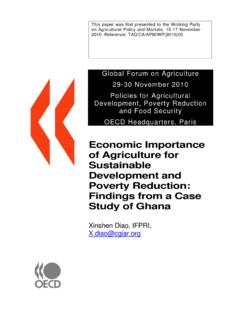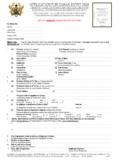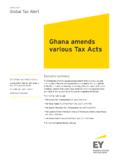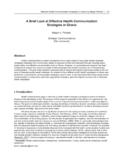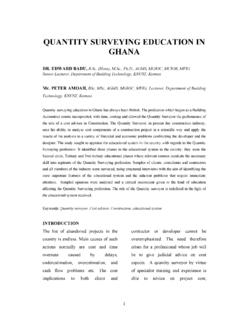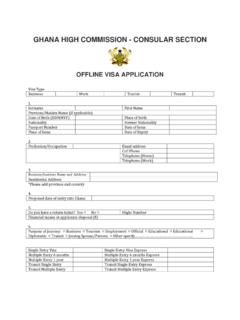Transcription of Socio-economic context and role of agriculture Ghana
1 GhanaCountry faCt sheet on food and agriculture poliCy trendsMarCh 2015 FAPDA - Food and agriculture Policy Decision AnalysisSocio- economic context and role of agricultureGhana is a middle-income West African country which expe-rienced impressive economic growth from 2005 to 2012. This growth has slowed significantly since 2013 in light of macro- economic challenges, such as high budget deficit and inflation, but is still expected to remain positive, due to the country s stable democratic institutions and rich natural capita GDP reached US$ 1 858 in 2013, and the Human Development Index improved as access to health care and education increased, making Ghana one of the few medium human development countries in the region. Ghana halved extreme poverty from percent to percent between 1991 and 2006, achieving one of the best records in sub-Sa-haran Africa. Furthermore, Ghana has met the Millennium Development Goal of halving poverty and hunger before 2015 (MDG1).
2 2 Nevertheless, over a quarter of the popu-lation still remains below the poverty line of US$ , particularly in the Northern is a key sector of Ghana s economy, account-ing for 23 percent of the national GDP in 2012. The sector Selected indicators2007200920112013 socio -ECONOMICGDP (current billion US$) * per capita (US$) *1 0991 0971 5941 858 Agricultural value added (% of GDP) *29322522 Agricultural value added (annual % growth) *(average 2007-2013) (2013) population (thousand)22 52623 69224 82125 905 Rural population (% of total) labour force (% of total labour force) Development Index **(2013) (ranking 138)AGRICULTURAL PRODUCTION & TRADEPer capita cultivated land (ha) equipped for irrigation (ha)34 000 (2012)Value of total agriculture production (constant gross value 2004-2006, billion US$)7 7609 33112 52210 717 (2012)Value of cereals production (constant gross value 2004-2006, billion US$)5731 1261 2121 079 (2012)Yield for cereals (hg/ha)13 17016 59815 94216 857 Cereal import dependency ratio (%)(2007-2009) 3 commodities Production quantityCassava; Yams; Plantains (2012)Production valueYams; Cassava.
3 Cocoa beans (2012)Import quantitySugar Refined; Wheat; Chicken meat (2011)Import valueSugar Refined; Chicken meat; Wheat (2011)Export quantityCocoa beans; Sugar Refined; Cashew nuts, with shell (2011)Export valueCocoa beans; Cocoa Butter; Cashew nuts, with shell (2011)Top 3 trade partners Import valueBrazil; Canada; Belgium (2011)Export value ^^South Africa, India, United Arab Emirates (2012)FOOD SECURITY & NUTRITIONTop 3 commodities available for consumptionCassava and products; Yams; Rice (Milled Equivalent) (2011)Per capita food supply (kcal/capita/day)2 7702 9373 003 NAGeneral (g) and Food (f) CPI (2000=100) (g), (f) (g), (f) (g), (f)678 (g), (f)People undernourished (million) (2008-2010) (2011-2013) (2010 2012)Proportion of undernourished (%)(2008-2010) (2011-2013)<5 Prevalence of underweight children under 5 years of age (%) (2006) (2008)NANAP revalence of stunting among children under 5 years of age (%) (2006) (2008)NANAP revalence of wasting among children under 5 years of age (%) (2006) (2008)NANAG lobal Hunger Index ^(2013) (Moderate)Access to improved water sources (% of population) *81838687 (2012)Source: FAOSTAT; *Source: WB; **Source: UNDP; ^ Source: IFPRI; ^^Source: WITS.
4 (accessed on 29 January 2015)1 The 2012 report of the Worldwide Governance Indicators places Ghana between the 50th and 60th percentile on political stability, government effectiveness, and regulatory quality, rule of law, control of corruption and accountability. The country counts on an improving environment for democratic governance, coupled with a gradual improvement in the effectiveness of public institutions and persistent economic growth. Country Data Report for Ghana , 1996-2013, available at: Government of Ghana , 2013, Agricultural Sector Annual Progress Report, available at: COUNTRY FACT SHEET ON FOOD AND agriculture POLICY TRENDS | GHANAhas grown significantly since 2007, benefiting from high inter-national prices, particularly for its main exports such as Despite this growth, agriculture remains largely rain-fed and sub-sistence-based, with rudimentary technology used to produce 80 percent of total output.
5 The sector employs almost half of the national labor country s main agricultural commodities include cocoa, cassava, yam, banana and maize, as well as other cereals and fruits. Oil palm, cotton and coconut are also important cash crops. Production of food crops by smallholders has increased in recent years, but is still characterized by low productivity. Ghana is a net importer of agricultural products, importing mainly consumer-ready commodities such as rice, wheat, sugar and According to FAO s Monitoring and Analysing Food and Agricultural Policies (MAFAP) public expenditure analysis, the share of total public expenditure allocated to the food and agriculture sector as defined by MAFAP, including administrative costs, fluc-tuated between 3 and 5 percent from 2006 to overall spending has increased, this has not resulted in the expected sustainable growth rate of 6 percent in agricultural GDP, which is the second CAADP objective under the Maputo Issues emerging from the public expenditure analysis are described in the last section of this fact sheet.
6 1. Government objectives in agriculture , food and nutrition securityThe national economic plan, known as Ghana Vision 2020 launched in 1995, envisions Ghana as the first African nation to become a developed country between 2020 and 2029 and a newly industrialized country between 2030 and 2039 through the integration of science and technology in governmental pro-grammes, including in the agricultural Ghana Shared Growth and Development Agenda (GSGDA 2010-2013) focused on supporting oil and gas devel-opment, with investments in infrastructure, energy, housing and agricultural modernization. GSGDA social policy has focused on human development, including health, education and the fight against Ministry of Food and agriculture s (MOFA s) stated vision is a modernised agriculture culminating in a structurally transformed economy and evident in food security, employment opportunities and reduced poverty.
7 7 In accordance with this vision, all gov-ernmental strategic frameworks and plans identify infrastructure development, agricultural research and extension as focus areas of policy intervention to achieve greater agricultural productivity for improved livelihoods. The approach adopted in governmental actions is meant to follow a market-driven logic and foresees greater engagement of the private the main objectives stated in the Food and agriculture Sector Development Policy (FASDEP II, 2007) is the moderni-zation of agriculture and increased productivity of Ghanaian farmers. The Medium Term agriculture Sector Investment Plan (METASIP 2010-2015) is the implementation plan of FASDEP II and comprises six programmes which represent Ghana s priorities, with Food Security and Emergency Preparedness and Increased Growth in Incomes being the major areas for National Social Protection Strategy (NSPS, 2008), launched in 2008, aims to manifest the government s vision of creating an inclusive and empowered society through the provi-sion of sustainable mechanisms for the protection of vulnerable people.
8 Its main objective is to meet the basic needs of extremely poor populations through social protection programmes and by improving access to livelihood Trends in key policy decisions (2007 to 2014) Producer-oriented policy decisionsDevelopment of the agriculture sector is a declared priority for the government. Supporting agri-food production and exports has been the leading policy since 2007, with particular empha-sis on agricultural modernization and ensuring minimum prices for farmers. Programmes implemented by MOFA at national level include the Fertilizer Subsidy Programme, the Block Farming Programme, Agricultural Mechanization Centers and the Irrigation Development Programme. It is estimated that these programmes together comprise about 85 percent of the ministry s capital Ghana is the world s second larger producer of cocoa, which is its main agri-food export and provides annual export revenues of over US$ 2 billion.
9 WTO, 2014, World Trade Policy Review, Ghana , available at: 4 USDA Gain Report, Ghana Exporter Guide, 2012, available at: MAFAP, 2014, Analysis of public expenditure in support of the food and agriculture sector in Ghana , 2006-2012. Internal document. See final section of the fact sheet for more The Maputo Declaration Target, adopted in 2003, rallied African governments to increase spending in the agricultural sector to stimulate agricultural growth, reduce poverty, and build food and nutrition security. Government of Ghana , 2013, Government of Ghana , 2013, Agricultural Sector Annual Progress Report, This leaves only 15 percent of the overall agricultural budget for regional and district-level departments of MOFA to utilize in carrying out their core activities. IFPRI, 2014, Decentralizing Agricultural Public Expenditures, available at: COUNTRY FACT SHEET ON FOOD AND agriculture POLICY TRENDS | GHANARe-introduction of input subsidiesAfter nearly twenty years of no large-scale government inter-vention in the fertilizer sector, a national Fertilizer Subsidy Programme was re-introduced in 2008, as a temporary response to spikes in domestic food and fertilizer prices that The pro-gramme subsidized all-size crop farmers, covering approximately 50 percent of fertilizer prices, and was distributed in the form of fertilizer-specific and region-specific vouchers.
10 Rather than disman-tling the programme after the price crisis, as originally planned, government support to the programme was scaled-up from US$ million in 2008 to US$ 63 million in 2012, although the overall subsidy was reduced to 21 percent in 2013, due to rising fertilizer prices and budgetary The programme aims to increase the rate of fertilizer application among farmers, which is one of the lowest in the world. However, even after implemen-tation of the input subsidy programme, fertilizer consumption has remained and expansion of mechanization servicesBecause of the low level of agricultural mechanization in the coun-try,13 the government launched the agriculture Mechanization Services Enterprises Centres (AMSECs) programme in 2007 as a credit facility, assisting qualified private sector companies in pur-chasing agricultural machinery at a subsidized price and interest rate which in turn is rented to rural farmers at affordable prices.










